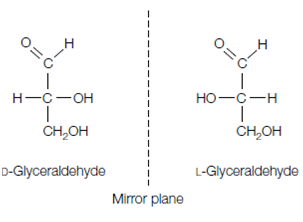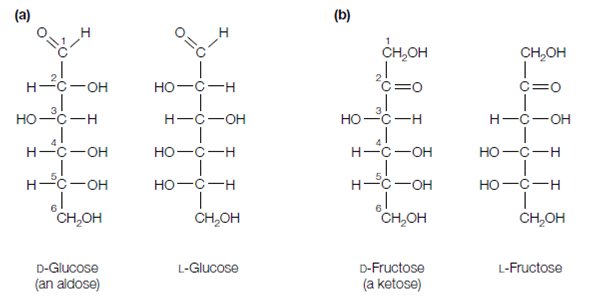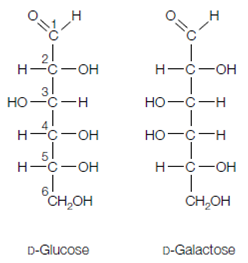Stereoisomers:
Glyceraldehyde has a single asymmetric carbon atom the central one and so two stereoisomers which is also called optical isomers are possible, which is two forms of glyceraldehyde, indicate as D- and L-glyceraldehyde, that are mirror images of each other shown in below figure. Stereoisomers also exist for amino acids.
Sugars with four, five, six or seven carbons are known as pentoses, tetroses, hexoses and heptoses respectively. In these cases the sugars should have more

Figure: D- and L-glyceraldehyde are mirror images of each other (stereoisomers or optical isomers).

Figure: (a) D- and L-glucose; (b) D- and L-fructose.
than single asymmetric carbon atom. The principle for numbering carbon atoms and naming configurations is as given below:
- the carbon atoms are numbered from the end of the carbon chain beginning with the aldehyde (that is carbon 1, C-1) or ketone group (that is commonly C-2);
- the symbols L and D refer to the configuration of the asymmetric carbon atom furthest from the ketone or aldehyde group.
Therefore, for instance, glucose, an aldohexose, exists as L and D forms. The furthermost asymmetric carbon from the aldehyde set is C-5. The D-Glucose is known as D because the configuration of the atoms bonded to C-5 is the similar as for D-glyceraldehyde. As same D-fructose a ketohexose is designated D because the configuration at C-5 matches that for D-glyceraldehyde. D sugars which are differing in configuration at only a single asymmetric carbon atom are called epimers. Therefore D-glucose and D-galactose are epimers and differing only in their configuration at C-4.

Figure: The epimers D-glucose and D-galactose.